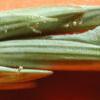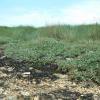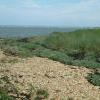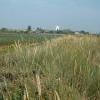35.063 Psamathocrita argentella Pierce & Metcalfe, 1942
Status and Distribution
Formerly considered Endemic to the British Isles, DNA barcoding of specimens from England, France, Hungary and Italy have shown it is more widespread than previously assumed (Keld Gregersen pers. comm.). In Britain, only known from several coastal localities within Dorset, Hampshire, Isle of Wight and West Sussex where it can be locally common. It has very occasionally been attracted to light a few kilometres inland. A widely published record from VC12 in 1993 is now considered unconfirmed (M. Wall pers. comm.) and the dot will be edited on the next map refresh in 2024.
Provisional map
Pupa
Set Specimens
Photographs of a set male and female can be seen on the Natural History Museum, Cockayne collection website:
Finding the Moth
Larva: developing flowers and seeds should be searched for the presence of adhering white frass.
Adult: flies mainly at dawn but also at dusk where it has been seen running up the grass stems and resting with wings open. It has also been observed flying around the foodplant after heavy rain at 1630hrs in good numbers. On occasions females can be found with their ovipositors trapped in the grass spikelets by the stiff scale-like glumes and lemmas.
Similar Species
Similar in size, shape and markings to Psamathcrita osseella from which it is best separated by dissection.
It may be possible to differentiate the two by examination of the underside of the abdomen which is reddish-buff in P. osseella and whitish in P. argentella but this has not been tested in the field. The speces looks rather Elachista-like in shape and size, the hindwing shape being the best way to identify it as a Gelechiid.
Single brooded, from mid-June to mid-July although this is based on a limited number of records (18).
Earliest: 13th June 1987 (VC11)
Latest: 12th July 1985 (VC10)




